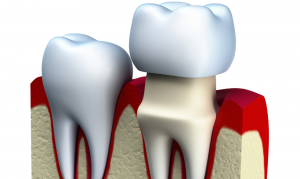What are Dental Crowns?

Crown restorations are one of the most familiar dental procedures dentists carry out. Daily, thousands of people have crowns placed to fix all kinds of tooth and mouth problems. Regardless of how common the process is, yet, dental crowns are occasionally not very well understood. In fact, some people are frightened or terrified by the prospect of having a crown restoration.

Dental crowns are nothing to be scared by. Not only are they vitally significant, they’re also not scary at all. The dental crown process is logical and straight-forward. More essentially, dental crowns themselves make very important functions for tooth and mouth health. Here’s all you should know about crowns, and why you shouldn’t be terrified if you need to have one.
What are Dental Crowns?
How do dental crowns work? Dental crowns are set prosthetic restorations made to reinstate a damaged tooth to its original form and size. They’re permanently cemented on teeth that have fractured, broadly decayed, or if not been damaged. Even though they sometimes extend down against the root surface, crowns basically replace the outer aspect of the “crown” part of a natural tooth, so it makes sense that the restorations are called “crowns.”
When affixed, the crown fully encases the part of the damaged tooth that sits on top of the gum line. Crowns are custom made to fit above each tooth. They can be made of an assortment of different materials, including ceramics, porcelain-and-metal, gold, or resin.
When are Dental Crowns Used?
Dentists install crowns to perform some important functions. They shield weak teeth, restore broken teeth, avoid cracked teeth from breaking further, and hold up teeth that have large fillings. Variants of crowns are also used to hold dental bridges primed. In each case, the crown supports or replaces a structure that no longer works on its own.
Whenever teeth are badly broken, misshapen, damaged, or cracked, crowns are the most efficient solution. Crowns reinstate the look, shape, and position of a damaged tooth. After a crown is lined in place, it’s more often than not the only visible fraction of the tooth. Crowns are made to look like ordinary teeth, so they won’t be prominent or look unusual inside the mouth.
How Do Dental Crowns Work?
Substitute Crowns fit on teeth much the similar way sewing thimbles fit on fingertips – they fit over the top of a tooth and care for what’s beneath it. They’re lined in place and, once affixed, act as a new top for the tooth whilst holding it together and keeping it from damage.
Crowns are constructed of very elastic and durable materials. They’re designed to bear the traumas of chewing just as efficiently as the rest of your teeth. Think of a crown as a cover for the top (visible) part of your tooth. After the dentist lines the crown to your damaged tooth, it basically becomes a part of that tooth.
How Are Dental Crowns Installed?
First, your dentist will apply anaesthetic to numb the tooth around the crown and the surrounding gum tissue. After that, they’ll use a dental drill and an abrasive bur to get rid of the outer surface of the tooth on the top and all sides, creating sufficient room for the crown to be located. If there’s not sufficient of the tooth left to hold up the crown, they may first add a crown buildup to produce a sound foundation on which the crown would sit. The dentist will then build an impression of the tooth using dental impression paste, putty, or a digital scanner. They send this impression to a dental laboratory to in fact make the crown.

It typically takes about two to three weeks to get the crown back from the dental laboratory after the dentist sends them the impression. It’s not good for the tooth to leave it uncovered more than that time, so your dentist will fix a temporary crown through your first visit. When the permanent crown arrives back at dentist’s office, you’ll have a second meeting with the dentist to fix it. The temporary crown will be separated and the new crown will be attuned to correctly fit your tooth and bite. Dentists then use a special cement to fix the crown to the tooth. When the cement cures, the crown is tightly attached to the tooth.
How Do Dental Crowns Help?
How do dental crowns help? Crowns bring back the shape, strength, functionality, and look of a damaged tooth. After you have one positioned you’ll be able to use your tooth to chew again with no risk of damage to what’s beneath it. Crowns care for the susceptible part of the tooth by physically holding it together and shielding it from injury.
Crowns are also significant to restoring and maintaining the structural veracity of your mouth and bite. When a tooth decays or breaks, it leaves a gap. That gap can make further problems when it interferes with your bite or when other teeth travel into it. By filling that gap, crowns reinstate your mouth’s proper structure. Finally, crowns also reinstate the look of your mouth, as they are mostly impossible to tell apart from natural teeth.
Crowns are not the respond for each kind of tooth trouble, but they might be the answer to yours.


